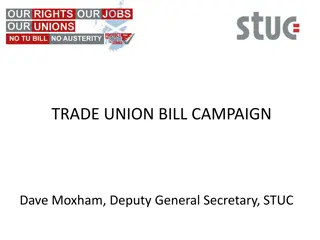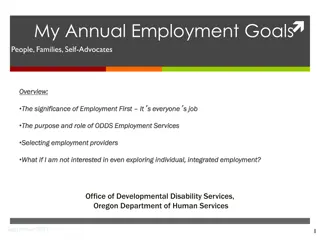Overview of Employment Equity Amendment Bill Public Comments
The presentation outlines the responses of the NCOP Select Committee to public comments on the Employment Equity Amendment Bill, including the constitutional mandate, purpose of the EEA, areas of agreement in the Bill, and consultation process with sector stakeholders. Key matters arising from public hearings include constitutionality of sector-specific EE targets, consultation processes, and employer obligations for EE compliance.
Download Presentation

Please find below an Image/Link to download the presentation.
The content on the website is provided AS IS for your information and personal use only. It may not be sold, licensed, or shared on other websites without obtaining consent from the author. Download presentation by click this link. If you encounter any issues during the download, it is possible that the publisher has removed the file from their server.
E N D
Presentation Transcript
NCOP (SELECT COMMITTEE) DEL s responses to the public comments on the Employment Equity Amendment Bill 8/03/2022 1
Presentation outline Introduction - Constitutional Mandate Purpose of the Employment Equity (EEA) DEL s responses to written and oral submissions/ Public hearings matters arising on EE Amendment Bill Process of the issuing of EE Certificate of compliance (section 53) Areas of Agreement to correct in the Amendment Bill Update on the Consultation process with the Sector Stakeholders for the setting of Sector EE Targets 2
Introduction Constitutional mandate Section 9 Everyone is equal before the law and has the right to equal protection and benefit of the law. Section 9(2): Equality includes the full and equal enjoyment of all rights and freedoms. To promote the achievement of equality, legislative and other measures designed to protect or advance persons or categories of persons, disadvantaged by unfair discrimination may be taken. Section 9(3): The state may not unfairly discriminate directly or indirectly against anyone on one or more grounds, including race, gender, sex, pregnancy, marital status, ethnic or social origin, colour, sexual orientation, age, disability, religion, conscience, belief, culture, language and birth. 3
Constitutional mandate Section 9 cont.. Section 9(4): No person may unfairly discriminate directly or indirectly against anyone on one or more grounds in terms of subsection (3). National legislation must be enacted to prevent or prohibit unfair discrimination. Section 9(5): Discrimination on one or more of the grounds listed in subsection (3) is unfair unless it is established that the Discrimination is fair. 4
Purpose of the EEA To achieve equity in the workplace by: Promoting equal opportunity and fair treatment in employment through the elimination of unfair discrimination; and Implementing affirmative action measures to redress the disadvantages in employment experienced by designated groups, in order to ensure their equitable representation in all occupational levels in the workplace 5
Public comments and hearings Matters arising on EE Amendment Bill The following key matters arose from the written and oral presentations/ public hearings: Constitutionality of Sector Specific EE targets vs Quotas (section 15(3) of the EEA vs section 15A) vs framework required by section 217 of the Constitution Section 16 on consultation with employees on sector EE targets Section 42 on Reasonable steps taken by employers vs Justifiable reasonable grounds (section 53(6)(b) of the Bill) Section 53 (6) of the EE Amendment Bill EE Compliance certificate vs BBBEE Certificate and Procurement law Penalties(Schedule 1 of the EEA) vs Sector EE Targets and DEL s capacity to enforce amendments. 6
Section 15 of the EEA Section 15 (1) states that: Affirmative action measures are measures designed to ensure that suitably qualified people from designated groups have equal employment opportunities and are equitably represented in all occupational levels in the workforce of a designated employers. Section 15 (2) states that: Affirmative action measures implemented by a designated employer must include (a) Measures to identify and eliminate employment barriers, including unfair discrimination, which adversely affect people from designated groups: (b) Measures designed to further diversity in the workforce in the workplace based on equal dignity and respect of all people; (c) Making reasonable accommodation for people from designated groups in order to ensure that they enjoy equal opportunities and are equitably represented in the workforce of a designated employer; 7
Section 15 of the EEA Cont (d) Subject to subsection (3), measures to (i) Ensure the equitable representation of suitably qualified people from designated groups in all occupational levels in the workforce; and (ii) Retain and develop people from designated groups and to implement appropriate training measures, including measures in terms of an Act of Parliament providing for skills development. Section 15 (3) states that: The measures referred to in subsection (2)(d) include preferential treatment and numerical goals, but exclude quotas. Section 15 (4) states that: Subject to section 42, nothing in this section requires a designated employer to take any decision concerning an employment policy or practice that would establish an absolute barrier to the prospective or continued employment or advancement of people who are not from designated groups. 8
Constitutionality of Section 15A (Quotas vs EE Targets) Quotas Sector EE Targets Mandatory outcomes Aspirational goals Rigid and must be achieved at all cost Flexible, but attempts must be made to achieve the goals, where reasonably practicable. Flexibility already built into the Draft EE Regulations, 2018 justifiable reasons in EEA15 form. Penalties instituted for missed outcomes - no consideration of justifiable reasons 9
Constitutionality of Section 15A (Quotas vs EE Targets) Cont Name of organisation Matters arising DEL s response The current targets in hard-coded form with the current fines and penalties contained in the EEA amount to quotas as non- compliance can impact the licences of financial services providers. Disagree with the arguments by FIA that sector targets set in terms of section 15A of the Bill are hard-coded and amount to quotas, as a result, are unconstitutional in terms of the Constitutional Court judgement in the South African Police Service v Solidarity obo Barnard 2014 (6) SA 123 (CC). Financial Intermediaries Association of Southern Africa (FIA) The Constitutional Court in South African Police Service v Solidarity obo Barnard 2014 (6) SA 123 (CC) has emphasised that: o suitably qualified individuals must be the beneficiaries of affirmative action under the EEA; and o measures directed at affirmative action may include preferential treatment and numerical goals but must exclude quotas It is important for the Committee to note that it was agreed at NEDLAC with all social partners that to ensure that sector targets set in terms of section 15A are not quotas, flexibility must be created to allow employers to regulate/ set their own Annual targets towards achievement of the Minister s regulated sector targets this will be done after consultation with employees as per section 16 read with section 17 of the EEA. In addition, NEDLAC social partners agreed that employers should be given an opportunity to raise a justifiable reason/ reasonable ground for failure to comply with the self-regulated annual targets before any punitive measures can be taken against the employer. Such sanctions include, not issuing an EE Compliance Certificate or referring non- compliance to the Labour Court for a penalty. 10
Constitutionality of Section 15A (Quotas vs EE Targets) Cont Name of organisation Matters arising DEL s response If the numerical targets which are set constitute an absolute barrier or quota, which the withholding of a certificate and with the opportunity to bid for Government work will do, that would fall foul of section 15(3) of the EEA. Disagree with the arguments by BUSA that sector targets may constitute a barrier or quota, if a certificate will be withheld for non- compliance. BUSA We are disappointed that BUSA is distancing itself from the NEDLAC Agreement where all social partners, including BUSA agreed that to ensure that sector targets set in terms of section 15A are not quotas, flexibility must be created to allow employers to regulate/ set their own Annual targets towards achievement of the Minister s regulated sector targets; and in addition, employers should be given an opportunity to raise a justifiable reason/ reasonable ground for failure to comply with the self-regulated annual targets before any punitive measures can be taken against the employer. Such sanctions include, not issuing an EE Compliance Certificate or referring non- compliance to the Labour Court for a penalty. Giving the Minster or any of his or her officials the power to set targets by decree outside of the legislation promulgated specifically to give effect to section 217(3) without setting a similar legislative framework within which this is to be done, in those circumstances, conflict with both sections 217 (1) and 217 (3) of the Constitution, and not be rescued by the proviso in section 217(2), which of itself needs to comply with section 217 (3). Furthermore, the framework within which sector targets will be set is prescribed in the draft EE Regulations, 2018 as agreed by social partners. There is nothing unconstitutional in this matter. 11
Constitutionality of Section 15A (Quotas vs EE Targets) Cont Flexibility is build in two ways: (1) Employers have powers to set their own Annual EE Targets in their own EE Plan through consultation with employees/ trade unions in terms of section 16 of the EEA towards achieving the regulated Sector EE Target (over 3 or 5 year period). (2) Regulation 16(4)(a) states that: Justifiable reasonable grounds for not complying with the targets, includes: Insufficient recruitment opportunities; Insufficient promotion opportunities; Insufficient target individuals from the designated groups with the relevant qualification, skill and experience; Court Order; Transfer of business; Mergers/Acquisitions; and Impact on Business Economic circumstances. In light of the above discussion on flexibility, it is clear that Sectoral EE targets are not Quotas. 12
Section 15A of the EE Amendment Bill Name of organisation Matters arising DEL s response Sector target should be set with the respective industry in a joint consensus seeking approach; and Agree that where possible, consensus must be reached with sector stakeholders on the setting of sector targets. Business Unity South Africa (BUSA) Act needs to make provision for instances where agreement cannot be reached between the Minister and the relevant sector However, we disagree that the Bill must make a provision for another processes in instances where there is no agreement on the sector targets. After 24 years of the EEA with no significant progress due to self-regulation by employers, we believe the Minister must be given powers to still regulate sector targets after consultation with sector stakeholders and on the advice of the Commission for Employment Equity.. Since there is insufficient empirical evidence to enable the setting of targets. CASA commits to collaborate with DEL in conducting research that will inform rational target setting as short term measure. Disagree, there is no need for research. Sufficient empirical evidence from the EE data collected from employers in the Construction sector through EE reports submitted annually to DEL this data indicates that there is insignificant transformation in this sector. Construction Alliance South Africa (CASA) 13
Section 15A of the EE Amendment Bill (Cont ) Name of organisation Matters arising DEL s response Section 15A is silent on the criteria for identifying and setting sectoral numerical targets. Disagree, section 15A is clear that the Minster may identify national economic sectors taking into account any relevant code contained in the Standard Industrial Classification of all Economic Activities published by StatSA this was done and 18 economic sectors were identified and published for public comment in the Draft EE Regulations, 2018. NEDLAC social partners agreed on these sectors and no opposing public comment was received on these sectors. Master Builders South Africa (MBSA) Section 15A is silent on the need for consensus between the Minister and the economic sectors in determination of numerical targets, which demonstrates adequate consultation and is crucial to setting and achievement of any targets set. MBSA proposes that section 15A(2) should include a requirement for the Minister to determine a criteria for identifying and setting sectoral numerical targets jointly with the economic sectors. Agree that where possible, consensus must be reached with sector stakeholders on the setting of sector targets, but the Minister must still have powers to set targets where there is no consensus upon receipt of advice from the Commission for Employment Equity (CEE). Section 15A(3) gives powers to the Minister to set targets in consultation with the National Minimum Wage Commission and not the relevant sector, This is concerning as this is not in alignment with the NEDLAC agreements discussed by business and the social partners. BASA recommends that the Minister reverts back to the NEDLAC agreement. Disagree, BASA commenting on the incorrect version of the Bill. The Bill was corrected by the Portfolio Committee on Employment and Labour to revert back to NEDLAC agreement to enable the Minister to set sector targets after consulting the relevant sector stakeholders and on the advice of the CEE. The banking Association of South Africa (BASA) 14
Section 15A of the EE Amendment Bill (Cont ) Name of organisation Matters arising DEL s response 15A (2) Minister may, after consulting in consultation with the relevant sectors including Regulators where applicable, and with the advice of the Commission, for the purpose of ensuring the equitable representation of suitably qualified people from designated groups at all occupational levels in the workforce, by notice in the Gazette set numerical targets for any national economic sector identified in terms of subsection (1). Disagree with the proposed amendment to section 15A(2) to delete the words after consultation and the new insertions of the words in consultation with and including Regulators where applicable because it is important that the Minister should have powers upon receipt of an advice from the Commission for Employment Equity to regulate sector targets in instances where there is no consensus reached with the relevant sector stakeholders. Otherwise, the intended objective of sector targets will be defeated and the mischief of employer s self- regulated targets, which never worked over 24 years of EEA will be perpetuated no transformation of workplaces will be realised in our lifetime. Disagree with the proposed amendments to section 15A(3) to cater for skills requirements because employers had over 24 years of Skills Development Act to develop the skills set required to transform their workplaces. Financial Intermediaries Association of Southern Africa (FIA); Association for Savings and Investment South Africa (ASISA); and 15A (3) A notice issued in terms of subsection (2) may set different numerical targets for different occupational levels, sub-sectors or regions within a sector or on the basis of any other relevant factor. Where a sector provides sufficient reasons for such a distinction, such as a difference in skills requirements, the Minister may set different numerical targets per sub-sector or region. South African Insurance Association (SAIA) 15A(4) A draft of any notice that the Minister proposes to issue in terms of subsection (1) or subsection (2) must be published in the Gazette, allowing interested parties at least 30 90 days to comment and engage with the Minister thereon. Disagree with the proposed 90 days because the 30 days prescribed in the Bill is the minimum time frame required and not a maximum period for the publication of a notice. Disagree that the Minister must again engage with the sector after publication of notice. 15
Section 15A of the EE Amendment Bill (Cont) Name of organisation Matters arising DEL s response BASA of the view that sector targets should be set nationally and not differentiated by region. If regional targets apply, then businesses with national footprint will have to comply with multiple sets of targets. This will result in a considerable burden in terms of restructuring, managing and monitoring the compliance requirements for businesses that operate nationally. Agree that national organisations like BASA should not be forced to comply with regional sector targets, but with national sector targets. In this regard, the concern by BASA will be catered for, if the proposed amendment submitted by COSATU on Section 42(a) of the principal Act, to change the word and to or is considered and accepted by this Committee. The banking Association of South Africa (BASA) The proposed amendment by COSATU to section 42(a) will enable organisations like BASA that operate nationally to choose between national and regional demographics of the Economically Active Population (EAP) Therefore, we request the Committee to consider the proposed amendment to Section 42 (a) as proposed by COSATU in their oral submission/ presentation. (See slide 19 hereunder) 16
Section 16 vs section 15A of the EE Amendment Bill Name of organisation Matters arising DEL s response The effect of the proposed amendments is that the Minister may impose sectoral numerical targets. These prescribed numerical targets will effectively override the targets contained in a designated employer s employment equity plan. Disagree with arguments by BUSA that the sector targets set by the Minister in terms of section 15A will disempower employers to consult with employees and are in conflict with the requirements of section 16 read with section 17 of the EEA, because BUSA was part of the NEDLAC Agreement, where in all NEDLAC social partners agreed that employers should be given powers to regulate their own Annual targets in the EE Plan towards achievement of their relevant sector targets in consultation with the employees as required by sections 16 and 17 of the EEA. BUSA However, in terms of section 16, read with section 17, of the current employment Equity Act, designated employers are legally required to consult with their employees (by way of an employment equity committee) on the content of the targets to be achieved) and implementation of their employment equity plans. If the EEA is amended, it will mean that an employer will be bound to use the sectoral targets fixed by the Minister in its employment equity plan, and consultation with employees would be rendered meaningless. The employer s hands will be tied, regardless of the input from its employees. BUSA does not believe that this disempowering consequences should be allowed to stand, given its potential disruptive effect on workplace harmony and labour relations. In fact, it is important to highlight that the implementation plans for the amendments is that the Minister would regulate sector targets for a period not less than three years and not more than five years, to allow the regulatory flexibility for employers in consultation with their employees to regulate their own Annual targets in the EE Plans towards the achievement of the sector targets. 17
Section 20(2A) and Section 42(1)(aA) of the EE Amendment Bill Name of organisation Matters arising DEL s response Disagree with the proposed deletion of the word sectoral employers are required in terms of Section 15A to align their numerical goals in their EE Plans with sector targets set by Minister, in this regard, the word sectoral is intended to link the EE numerical goals in the employer s EE Plan with the sector targets regulated in terms of section 15A. Financial Intermediaries Association of Southern Africa (FIA); Section 20(2A): (2A) The numerical goals set by an employer in terms of subsection (2) must comply with any sectoral target in terms of section 15A that applies to that employer. Association for Savings and Investment South Africa (ASISA); and South African Insurance Association (SAIA) Disagree with the proposed amendments because section 53(6) of this Bill already caters for the prescription of the justifiable reasons/ reasonable grounds for failure to achieve the set sector targets. Furthermore, the justifiable reasons/ reasonable grounds are already prescribed in Regulation 16 and in the EEA15 form in the Draft EE Regulations, 2018, which was agreed upon by NEDLAC Social Partners, including Organised Business. FIA; ASISA; SAIA; and BUSA Section 42(1)(aA): (aA) whether or not the employer has complied with a sectoral target or taken reasonable steps to comply with/ achieve the applicable target as set out in terms of section 15A applicable to that employer. 18
Section 42(a) of the EE Amendment Bill, 2018 (formed part of NEDLAC Agreement) Name of organisation Matters arising DEL s response It is important for targets to take into account regional and sub-regional demographic diversity; Agree with the proposal by COSATU that it is important for targets to take into account regional demographic diversity because South Africa is a diverse nation and this is often linked to geography. Therefore, we request the Committee to consider the proposed amendment to Section 42(a) of the principal Act as proposed by COSATU as this amendment formed part of the NEDLAC agreement and was mistakenly omitted in the Bill tabled in Parliament. (vs: page 4, paragraph 3.9 of NEDLAC Report) If agreed by Committee, section 42(a) will read as follows: COSATU South Africa is a diverse nation and this is often linked to geography; A blanket uniform approach does not work and one size fits all targets can cause social strife; and Provisions requiring Minister to engage when setting targets with Employment Equity Commission will help to ensure targets are thoroughly considered beforehand. In determining whether a designated employer is implementing employment equity in compliance with this Act, the Director-General or any person or body applying this Act may, in addition to the factors stated in section 15, take the following into account (a) The extent to which suitably qualified people from and amongst the different designated groups are equitably represented within each occupational level in that employer s workforce in relation to the demographic profile of the national and or regional economically active population; 19
Section 53 of the EE Amendment Bill Name of organisation Matters arising DEL s response Disagree with the proposed additions because it will be difficult to measure reasonable steps taken by employers, and even if we were to prescribe/ define the reasonable steps, we run the risk of opening a flood gate of condoning non-compliance with the requirements of the EEA. In fact, the reasonable steps were removed from section 42 through the 2013 amendments of the EEA to mitigate the risks of limiting the compliance and enforcement mechanisms of this Act. Financial Intermediaries Association of Southern Africa (FIA); Section 53(6)(a): (6) The Minister may only issue a certificate in terms of subsection (2) if the Minister is satisfied that (a) the employer has complied with a numerical target set in terms of section 15A that applies to that employer or has taken reasonable steps to comply with those targets; Association for Savings and Investment South Africa (ASISA); and South African Insurance Association (SAIA) Disagree because it was agreed by NEDLAC Social partners that justifiable/ reasonable grounds must not be included in the Bill itself, but in the regulations to create regulatory flexibility to cater for future developments. Rationale is that, it is less complex to review and amend the Regulations through NEDLAC process, rather than amending the Act, which has to go through the Parliamentary process. Justifiable grounds in the Draft EE Regulations, 2018 were agreed by NEDLAC and no opposing public comments were received on these. Section 53(6)(b): In relation to section 53(6)(b), the Bill must set out factors that are to be considered in determining whether an entity has a reasonable ground which justifies non- compliance, and that these factors should be included in the Bill itself. ASISA and SAIA suggest that the grounds contained in the draft 2018 regulations should be used for this purpose, with the inclusion of level of progress made towards achieving the targets and any other relevant factor . 20
Section 53 of the EE Amendment Bill (Cont) Name of organisation Matters arising DEL s response Master Builders South Africa (MBSA) Section 53(6)(b): The section is silent on the definition of acceptable reasonable grounds to justify a failure to comply this may be subject to abuse. Disagree with the proposal that acceptable reasonable grounds should be defined in the Act. It was agreed by NEDLAC Social partners that justifiable/ reasonable grounds must not be included in the Bill itself, but in the regulations to create regulatory flexibility to cater for future developments. MBSA proposes that clear definitions of acceptable reasonable grounds to justify a failure to comply should be included in the Act. A compliance period of no less than the minimum required for completion of an occupational qualification dominant for each sector, should be included in the definition of acceptable reasonable grounds for failure to qualify. Disagree with this proposal to include a minimum period to complete a qualification as part of reasonable grounds for failure to comply how do you cater for the skills needs of each sector this will be cumbersome and open to abuse by employers in each sector. Furthermore, justifiable reasons in the Draft EE Regulations, 2018 already agreed by NEDLAC Social partners and no opposing public comments were received in this regard. 21
Section 53 of the EE Amendment Bill (Cont) Name of organisation Matters arising DEL s response BUSA Section 53(6)(b): The criterion that an employer should not have had any unfair discrimination findings from the CCMA or Labour Court in the last 12 months, is irrational and unduly onerous. It allows the Minister the power to usurp the powers of those forums to determine their own dispute resolution processes and to assess appropriate remedies. For example, an employer may be ordered to pay money or restore the position of a wronged employee. To prevent such an employer for bidding for State contracts amounts to double punishment and is unjustified. Disagree with the arguments by BUSA that the criterion for issuing of EE Compliance Certificate should not include in the criterion, the unfair discrimination cases by CCMA and the non-payment of national minimum wage because the criteria listed under section 53(6)(b) was agreed by all NEDLAC Social partners without any amendment (vs: NEDLAC Report, page 4, paragraph 3.10.1). In fact, we are perturbed by BUSA s arguments seeing that they are now dissociating themselves from the NEDLAC agreement. Similarly, the criterion on a finding about non-payment of minimum wages in the last 12 months is problematic. Appropriate remedies lie in the NMW Act and the LRA. 22
Fines and penalties (Not part of the EE Amendment Bill) Name of organisation Matters arising DEL s response The FIA does not believe that the current provisions in respect of fines which are levied for non-compliance with other sections of the Act, should apply to non- compliance with section 15A. FIA recommends that the Minister consult with the relevant sectors on the appropriate fines and penalties at the time of consultation on the sub-sector targets. FIA is concerned that excessive punitive fines will lead to regulatory failure and a systemic event. Disagree with the proposal from FIA, ASISA and SAIA that the current fines and penalties in Schedule 1 of the Employment Equity Amendment Act (EEAA), 2013 are inappropriate or should be applicable to non- compliance with sector targets set in terms of section 15A. Financial Intermediaries Association of Southern Africa (FIA) In fact, the issue of the current fines and penalties in the EEAA, 2013 was never a matter of concern to any social partner during the NEDLAC negotiations on the EE Amendment Bill. ASISA and SAIA recommend that the current fine regime not be applicable to non-compliance with targets set in terms of section 15A, and that this is a matter to be considered for inclusion as a topic for further consultation once the Bill has been promulgated, and prior to publication of notices in terms of section 15A. Association for Savings and Investment South Africa (ASISA); and We strongly believe that any kind of non- compliance with any provision of the EEA must be treated in the same manner and the Courts should apply the same sanctions/ penalties in Schedule 1 of the EEAA, 2013. South African Insurance Association (SAIA) 23
Section 53 (EEA) vs Procurement There is other compliance requirements with other laws outside Procurement, which are currently prerequisite for access to State Contracts such as: SARC Certificate; BBBEE Certificate; and Now EE amendment proposal is to add the EE Compliance Certificate to the list to expedite transformation of the economy. Rationale why Section 53 of the EEA was not promulgated in 1998 with section of the EEA: Employers required time to develop and implement systems and processes to comply with the requirements of the EEA, e.g. establish HR Systems to collect workforce data; conduct workplace analysis; develop and implement EE Plans with numeral targets and goals; and then submit EE Reports to reflect progress made; There were no tools and criteria in place to assess compliance, including regulations and systems to issue certificate of compliance under section 53 now tools and criteria are developed and 99.9% of EE Reports are submitted Online to enable collection of quality data and analysis of progress made in the labour market after 23 years of the EEA; and Proposed sector EE Targets is one of the key mechanisms to assess compliance of designated employers. 24
Process of Issuing of Compliance Certificate Issuing of EE Certificate of compliance will be done by declaration (EEA15 form) and automation through the EE System Online facility. Annual Assessment of Annual EE Targets will be conducted immediately through automated Online submission of EE Reports. Automation will make it easy to Save, Print and Email the certificate when required access to the certificate Online will be 24/7. EE System will be linked to the CCMA Case Management System and the NMW Exemption System to ensure back-end verification process with CCMA Arbitration Awards for discrimination cases; and to check if employers have been exempted from paying the NMW turn-around time will be expedited to issue certificate. No Manual Certificates will be issued by Labour Inspectors/ any official certificates will be issued automatically by the EE System after submission of EE Reports (designated employers); and Small employers/ non-designated employers certificate will be issued after submission of request for certificate (EEA15 form) Online. 25
Law enforcement vs corruption/bribery SAFCEC raised a concern about Labour inspectors receiving bribery in exchange of Certificate of compliance. We all concede that we live in an environment wherein corruption/bribery is rife but we cannot stop law enforcement only based on fear of corruption/ bribery. We must all deal with the two parties involved in corruption, i.e. the Corruptor and the receiver of bribery to ensure that we curb/ eliminate the scourge of corruption. We must continue to enforce the law - both labour laws and criminal laws must be enforced to maintain compliance, peace and stability in the labour market and society as a whole. Black Business Council in the Build Environment (BBCBE) proposes to forge partnership with the department to increase enforcement capacity there is no need to amendment the EEA and we are not adverse to partnerships. Proposals to partner with BBCBE or any other organisation are welcome as long as we can improve compliance with the EEA and transform the labour market. 26
Areas of agreement to amend in the EE Amendment Bill Department agrees with the following amendment to section 42(a) of the EE Amendment Bill, 2018 (part of NEDLAC agreement) as proposed by COSATU (see slide 19 above); and in this regard, request the Committee to consider the inclusion of this amendment in the current Bill. Upon the Committee s consideration and approval, Section 42(a) would read as follows: 42(a)In determining whether a designated employer is implementing employment equity in compliance with this Act, the Director-General or any person or body applying this Act may, in addition to the factors stated in section 15, take the following into account (a) The extent to which suitably qualified people from and amongst the different designated groups are equitably represented within each occupational level in that employer s workforce in relation to the demographic profile of the national and or regional economically active population; 27
Update on Consultation process with relevant Sector Stakeholders In June 2019, the Department and the Commission for Employment Equity started with the consultation process with each economic sector separately with the purpose of reaching consensus on the setting of EE sector specific targets for the designated groups, particularly at the top four occupational levels (Top Management; Senior Management; Professionally Qualified; and Skilled Technical level); and for persons with disabilities. Notwithstanding that the promulgation of the EE Amendment Bill is still underway in Parliamentary processes, the Department and CEE have made significant strides in relation to the consultation process with relevant sector stakeholders. Thus far, consensus have been reached on the sector targets with the Financial and Insurance sector and we are busy conducting follow-up engagements with other sectors regarding the department s proposed targets tabled in initial round of consultation. 28
Thank you 29






![RE: ELECTORAL MATTERS AMENDMENT BILL [ B42-2023]](/thumb/18837/re-electoral-matters-amendment-bill-b42-2023.jpg)

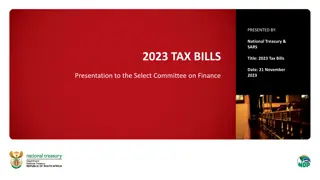
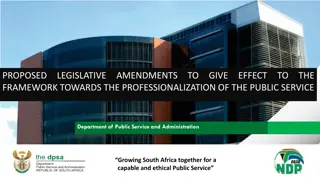

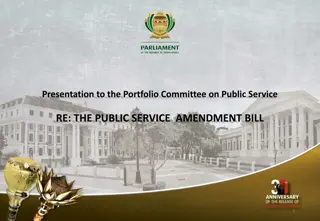

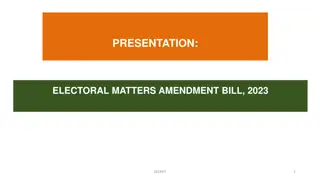
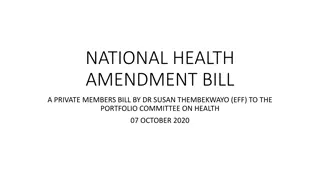
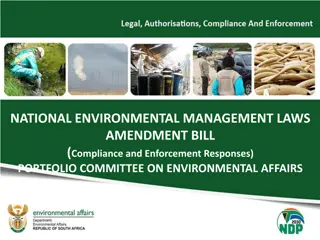

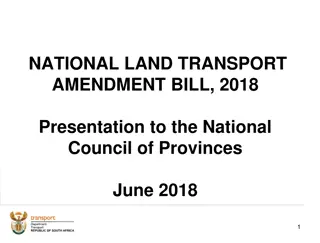
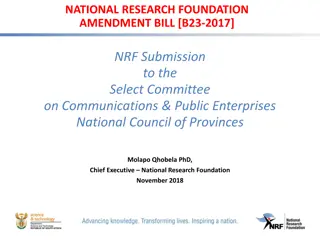

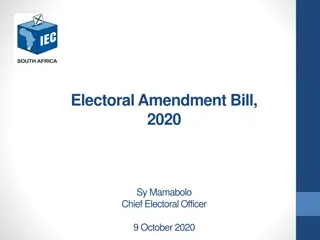

![Briefing on the Criminal Procedure Amendment Bill [B12-2021] to the Portfolio Committee on Justice and Correctional Services](/thumb/157093/briefing-on-the-criminal-procedure-amendment-bill-b12-2021-to-the-portfolio-committee-on-justice-and-correctional-services.jpg)


